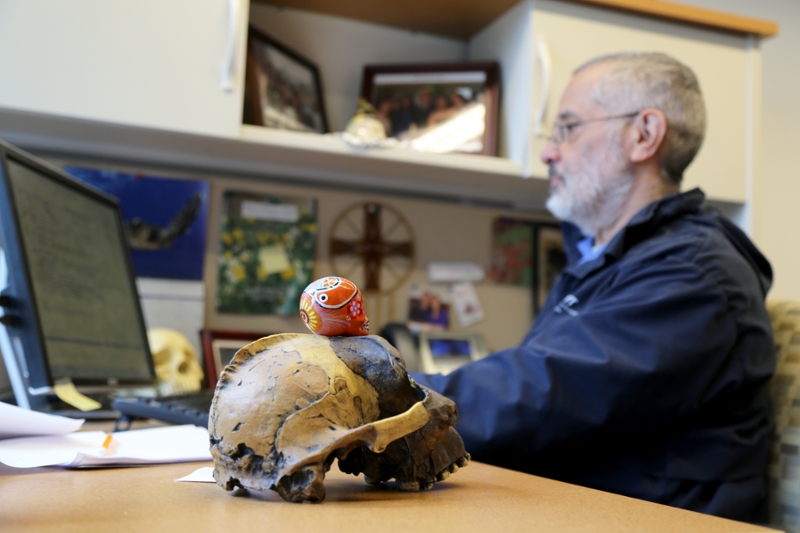by Bethany Romano

Ricardo Godoy sits in a quiet office on Heller’s ground floor in front of a computer screen flanked by two skulls. “That’s Australopithecus,” he says, gesturing first to the heavy-jawed one on the left, “and that’s homo sapiens. I always thought that these two guys are a nice summary of life—where we come from, and where we’re going. And in the middle is where we spend all this time sending emails, writing, and so forth. But the big picture is on either side.”
Every summer for the past 20 years, Godoy and a team of colleagues trek to a remote region of the Bolivian rainforest and work in 13 indigenous villages along a small tributary river to the Amazon. There, they study 2,000 Tsimane’, a native Amazonian society: taking measurements of their health, emotional welfare, culture and economy. Every year they ask the same questions, take the same measurements, and tediously record every piece of data. The goal? To see whether and how the ever-encroaching tide of modernization has changed this indigenous group.
“A lot of people think that modernization is the road to perdition, and others think that it’s the greatest thing on earth,” says Godoy, who hopes to understand how globalization affects this formerly isolated group. The work is unique. Of the very few longitudinal anthropological studies that exist, Godoy says only this one gathers socio-economic and biological data systematically over time.
In the decades since he first backpacked through the Bolivian jungle in search of a test site for his research, very little outside information or influence has made its way to the Tsimane’ people. (One year the research team asked the study subjects if they knew who the president of Bolivia was—most didn’t.) But other things have changed, especially for villages that are closest to town.
“When you put all the data together, you start to see some patterns,” says Godoy, “but the effects of modernization are very ambiguous. What we find are very mixed results—some things improve, others not so much. But on the whole, things get better.” The data show that Tsimane’ subjects are slightly stronger, healthier, even happier overall than they were when the study started. “The only indicator that seems to deteriorate is self-perceived health,” says Godoy. “We think that might have to do with the fact that as things get better, you tend to complain more,” he notes with a smile.
But change happens very slowly. And the changes Godoy’s team has detected are very small. So in addition to the slew of longitudinal data Godoy collects every year, he’s developed several side projects that capitalize on his good relationship with the Tsimane’ people to answer other basic questions about human culture and psychology.
A few years ago Godoy, who is an amateur musician and composer, began to wonder whether the connections we make between music and emotion are a function of nature or of nurture. In other words, do we automatically associate an upbeat tune with feelings of happiness because we’ve learned to associate them together, or is this a universal phenomenon based in human biology? Would a person who has had only minimal exposure to music associate the soundtrack of an Alfred Hitchcock film with fear?
To answer these questions, Godoy teamed up with professor Josh McDermott at MIT. They played snippets of music for Tsimane’ study participants, and asked them about emotional associations. “What we’ve found is that snippets of happy music are recognized as happy among this Amazon tribe, but what you and I might think of as sad music is not associated with sadness. Sadness seems to be much more cultural. You learn what’s sad, but there’s something universal about happiness.”
Godoy is also interested in randomized controlled trials, and has conducted several studies to learn more about the modernization of economic behaviors and incentives. For example, he partnered with Jere Behrman of Yale and William Leonard of Northwestern University in a study that provided large financial transfers to the poorest households in a Tsimane’ village. Surprisingly, they found that these transfers had no effect on the recipients, but did have an effect on villagers in the top 80 percent of the village income range, who did not receive cash transfers. These villagers reacted by learning more Spanish (Tsimane’ people are not native Spanish speakers). Godoy theorizes that providing targeted supplemental income to the poor might motivate those who are better off to react in an effort to maintain their status.

In addition to his ever-growing research agenda in the Bolivian Amazon, Godoy teaches as many as eight courses at Heller and mentors master’s and PhD students. He’s a favorite among Heller students, several of whom have published their first academic articles under his tutelage while working with Godoy’s original Tsimane’ data. After 20 years of fieldwork, he has a matter-of-fact attitude about the persistence required to succeed in academic research. “I’ve only done one thing in life, and that’s track these people,” he jokes in characteristic understatement.
For the first time in many years, Godoy will spend his upcoming summer not in the jungle, but sitting in the company of homo sapiens and Australopithecus, writing a long-awaited book. It will summarize Godoy’s life’s work—his decades of research with the Tsimane' and his conclusions about how modernization has affected the health and wellbeing of these formerly isolated people.
Ricardo Godoy is a Professor of International Development in the Center for Global Development and Sustainability. For Godoy’s relevant publications and data requests, visit the Tsimane' Amazonian Panel Study (TAPS) website.
